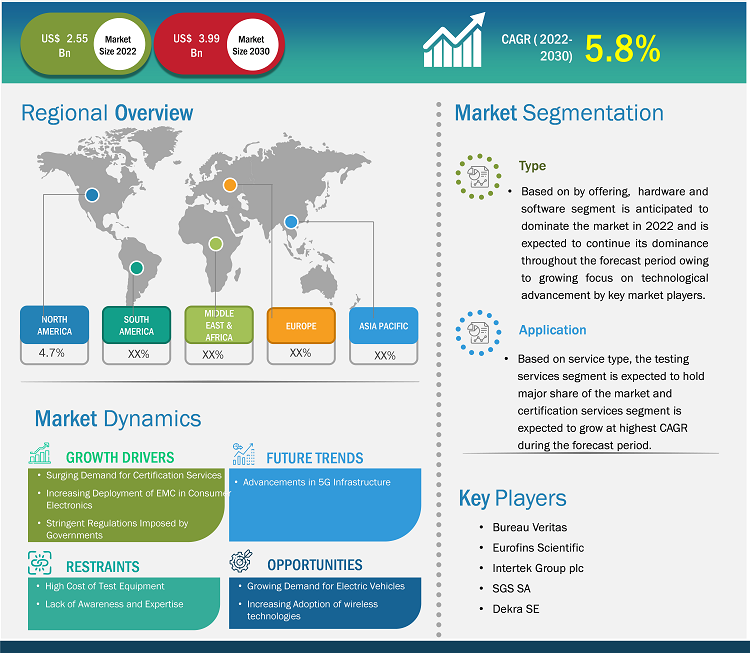$4450
$3560
The EMC testing market size is expected to reach US$ 4.48 billion by 2031 from US$ 2.85 billion in 2024. The market is anticipated to register a CAGR of 6.8% during 2025–2031.
EMC Testing Market Analysis
One major factor behind growth is the electrification of the automotive sector. This includes the increase in electric vehicles (EVs) and self-driving systems. These technologies have intricate electronic subsystems that require detailed EMC validation. The rapid launch of 5G infrastructure and the continuing growth of IoT ecosystems are also creating new testing challenges and expanding the market. Additionally, strict global regulations from groups like the FCC in the US, CE in Europe, and CISPR worldwide are urging manufacturers to meet compliance requirements.The market offers significant opportunities. The growth of 5G networks, smart grid technologies, renewable energy systems, and smart consumer devices will all need improved EMC testing. Also, using artificial intelligence (AI) and machine learning (ML) in test equipment and processes is becoming a major trend. This change enhances test speed, accuracy, and data analysis skills. Moreover, the rising focus on eco-friendly and sustainable EMC testing practices supports global environmental goals.EMC Testing Market Overview
Electromagnetic Compatibility (EMC) testing is important for assessing how well electronic devices deal with electromagnetic disturbances. It examines whether these devices keep functioning reliably amid electromagnetic interference. EMC testing makes sure that products meet international standards for both radiated and conducted emissions, as well as immunity standards. This testing plays a crucial role in ensuring the safety and performance of devices in different industries, such as automotive, aerospace, telecommunications, consumer electronics, and healthcare. As electronics and wireless technologies become more widespread, meeting EMC standards is becoming increasingly vital.
Customize Research To Suit Your Requirement
We can optimize and tailor the analysis and scope which is unmet through our standard offerings. This flexibility will help you gain the exact information needed for your business planning and decision making.
EMC Testing Market: Strategic Insights

Market Size Value in US$ 2.55 billion in 2022 Market Size Value by US$ 3.99 billion by 2030 Growth rate CAGR of 5.8% from 2022 to 2030 Forecast Period 2022-2030 Base Year 2022

Naveen
Have a question?
Naveen will walk you through a 15-minute call to present the report’s content and answer all queries if you have any.
 Speak to Analyst
EMC Testing Market Drivers and Opportunities
Speak to Analyst
EMC Testing Market Drivers and Opportunities
Customize Research To Suit Your Requirement
We can optimize and tailor the analysis and scope which is unmet through our standard offerings. This flexibility will help you gain the exact information needed for your business planning and decision making.
EMC Testing Market: Strategic Insights

| Market Size Value in | US$ 2.55 billion in 2022 |
| Market Size Value by | US$ 3.99 billion by 2030 |
| Growth rate | CAGR of 5.8% from 2022 to 2030 |
| Forecast Period | 2022-2030 |
| Base Year | 2022 |

Naveen
Have a question?
Naveen will walk you through a 15-minute call to present the report’s content and answer all queries if you have any.
 Speak to Analyst
Speak to Analyst
Market Drivers:
Rapid Growth of Certification Services:
Throughout the increased use of electrical and electronic appliances, several issues arose due to unwanted interference and radiation impacting the performance and safety of those devices. The closer and more devices work together, the more essential proper electromagnetic compatibility (EMC) and immunity to electromagnetic interference (EMI) should become. EMC testing and certification provide confirmation to the designer and potential end user that an electronic product is in compliance with ascending standards and ensure safe performance.Growing Adoption of EMC for Consumer Electronics:
In addition to new technologies, using faster clock speeds, higher data rates, and more variable voltage supplies continues to place demands on the potential for electromagnetic interference. Increasing efficiency, smaller or lighter devices, energy savings and regulation continue to fuel the pressure on manufacturers to attain reliable EMC shielding and testing to meet changing regulations, ensure end user safety, and product reliability. There is both a growing consumer electronics market, along with increased regulatory standards, which should expand the EMC testing marketRegulatory Requirements Imposed by Governments:
Regulatory requirements imposed by governments encompass obligations for complying with electromagnetic compatibility (EMC) standards in the interest of guaranteeing the safety and performance of devices. As a result, manufacturers have to spend additional money on EMC testing in support of legal and certification obligations. The demand for EMC testing services and equipment will continue to increase as regulatory structures develop around the world.
Market Opportunities:
Unprecedented Demand for Electric Vehicles
The extraordinary expansion of electric vehicles (EVs) is increasing the need for EMC testing to confirm that the vehicle components operate together without interference. As EVs use electronics as part of complex electronic systems, it is crucial to ensure the product meets electromagnetic compatibility (EMC) standards. This demand is boosting the need for EMC testing services, particularly in areas of automotive research & development, charging infrastructure, and battery management systems.
Expanding Use of Wireless Technologies
Wireless communication is becoming a requirement in many sectors such as healthcare, consumer electronics, and industrial automation. As an increasing number of products are becoming Bluetooth-, Wi-Fi-, and 5G-enabled, the risk of electromagnetic interference also increases. EMC testing ensures that devices with wireless capabilities can coexist without disruption, driving the demand for and expanding the services of compliance testing and certification services.Expansion of 5G Infrastructure
The global rollout of 5G networks brings new frequencies and faster data transmission rates. This requires careful EMC testing. Equipment used in 5G must meet strict compatibility standards to prevent interference with existing devices and infrastructure. This ongoing development creates significant opportunities for EMC testing labs, especially in telecommunications and connected devices.
Market Trends:
Artificial Intelligence in EMC
AI is disrupting EMC testing environments by automating complex test procedures, providing insight into patterns of interference, and predicting EMC compliance issues. Using AI has both reduced human errors, improved efficiency, and sped up product certification cycles. The capabilities of AI tools will continue to improve, and they will eventually become indispensable tools in many EMC testing environments in various sectors.
The growth in IoT devices and connected technologies in consumer and industrial products
The boom in IoT devices in homes, factories, and cities is increasing the complexity of electromagnetic environments. The integration of connected devices requires strict EMC compliance testing to ensure that they can work well together without interference. Due to the rapid proliferation and increased use of IoT devices, there is continuous innovation and heightened demand for EMC compliance and EMC testing services globally.Movement toward the Utilization of In-House EMC Testing Capabilities
A trend can be seen, however, many large manufacturers have established in-house EMC testing labs to help expedite the time to market and increase flexibility in testing. This trend is driven by greater product complexity and the need to test iteratively through the product development process. Having in-house EMC capabilities gives manufacturers better control, allows for quicker compliance and lower costs in the long term, changing the historical model of outsourced EMC testing.
EMC Testing Market Report Segmentation Analysis
The EMC testing market is divided into different segments for its growth potential and the latest trends. Below is the standard segmentation approach used in industry reports:
By Offering:
Hardware and Software
This segment is comprised of EMC testing instruments, analyzers, and software that use various devices to provide measurement and electromagnetic compatibility verification.Services
This segment focuses on assistance in specialized EMC testing, certification, consulting, and compliance services that are provided to manufacturers to assist in complying with regulatory requirements effectively & efficiently.
By Service Type:
Testing Services
This includes all EMC testing to determine a product's conformity to EMC standards and regulations.Inspection Services
This includes the inspection of devices and systems to determine potential EMC problems prior to formal testing or certification.Certification Services
This includes the official approval and documentation that a product meets the required EMC standards for entry into the marketplace.Other Services
This includes any other assistance such as consulting, training, and specifically tailored EMC solutions and services.
By End-Use:
- Consumer Appliances and Electronics
- Automotive
- Military and Aerospace
- IT and Telecommunications
- Medical
- Industrial
- Others
The EMC testing market serves many industries including, but not limited to, consumer appliances, automotive, military, aerospace, IT, telecommunications, medical, and industrial. These industries require strict electromagnetic compatibility (EMC) for safety, reliability, and regulatory requirements. The variety of applications and industries leads to continuous innovation and demand in the technology-based sector..
By Geography:
- North America
- Europe
- Asia Pacific
- South & Central America
- Middle East & Africa
EMC Testing Market Report ScopeEMC Testing Market Share Analysis by Geography
The EMC testing marketplace in Asia Pacific is evolving rapidly, largely driven by increasing uptake of next-generation electronic devices and expanding telecommunications infrastructure. Emerging markets in South & Central America, the Middle East, and Africa remain untapped for most EMC testing service providers, presenting opportunities to expand operation while benefiting from growing regulatory requirements.
The growth of the EMC testing market varies across regions due to differences in industrial development, regulatory frameworks, and technology adoption. Below is a summary of market share and trends by region:
1. North America
Market Share:
Significant share driven by advanced technological adoption and well-established regulatory standardsKey Drivers:
- Strong presence of automotive and aerospace industries requiring rigorous EMC compliance.
- High demand for consumer electronics and telecommunication devices.
- Government regulations enforce strict EMC standards across industries.
Trends:
Increasing integration of AI and IoT in EMC testing processes to enhance accuracy and efficiency.
2. Europe
Market Share:
Holds a significant share due to early adoption of strict and comprehensive EMC regulations across the European UnionKey Drivers:
- Strong presence of automotive, aerospace, and industrial manufacturing sectors demanding rigorous EMC compliance.
- Stringent regulatory frameworks such as the EMC Directive enforce high standards for product certification.
- Growing focus on renewable energy and smart grid technologies is increasing the need for reliable EMC testing.
Trends:
Increasing integration of Industry 4.0 technologies and smart sensors in manufacturing, driving advanced EMC testing requirements for sustainability and predictive maintenance.
3. Asia Pacific
Market Share:
Rapidly growing market driven by electronics manufacturing and telecommunications expansionKey Drivers:
- Surge in consumer electronics production and increasing smartphone penetration.
- Expanding 5G infrastructure demands stringent EMC compliance.
- Growing automotive and electric vehicle markets are fueling EMC testing demand.
Trends:
Increasing government focus on EMC standards enforcement and rising investment in testing infrastructure.
4. South and Central America
Market Share:
Developing market influenced by expanding industrial and consumer electronics sectorsKey Drivers:
- Growing automotive manufacturing and telecommunications infrastructure.
- Increasing foreign investments and collaborations in technology development.
- Rising awareness of regulatory compliance and certification importance.
Trends:
Adoption of in-house EMC testing labs by manufacturers to speed up product development cycles.
5. Middle East and Africa
Market Share:
Emerging market with untapped potential in telecommunications and industrial sectorsKey Drivers:
- Growing adoption of wireless technologies and IoT devices.
- Expansion of industrial automation and energy sectors requires EMC compliance.
- Increasing government initiatives to align with international EMC standards.
Trends:
Growing demand for portable and cost-effective EMC testing solutions.
EMC Testing Market Players Density: Understanding Its Impact on Business Dynamics
High Market Density and Competition
Competition is intense due to established players such as Bureau Veritas, Intertek Group plc, and SGS SA. Regional and niche providers such as Dekra SE (Germany) and Eurofins Scientific (Luxembourg) add to the competitive landscape across regions.
This high level of competition urges companies to stand out by offering:
- Advanced EMC testing solutions with AI-driven automation and analytics.
- Comprehensive services focused on regulatory compliance and faster certification.
Opportunities and Strategic Moves
- Growing adoption of AI and machine learning to enhance testing accuracy and efficiency.
- Increasing demand for sustainable and energy-efficient electronic products is driving EMC compliance requirements.
Major Companies operating in the EMC testing Market are:
- Ametek Inc – Pennsylvania, US
- Element Materials Technology Group Ltd – London, UK
- Bureau Veritas SA – Neuilly-sur-Seine, France
- Eurofins Scientific SE – Luxembourg
- Intertek Group Plc – London, UK
- Rohde & Schwarz GmbH & Co KG – Munich, Germany
- SGS SA – Geneva, Switzerland
- TUV SUD AG – Germany
- UL, LLC – Illinois, US
- TÜV NORD GROUP.– Hanover, Germany
Disclaimer: The companies listed above are not ranked in any particular order.
Other companies analyzed during the course of research:
- Element Materials Technology
- Signify
- Japan Testing Laboratories Co., Ltd.
- CESI SpA
- Kiwa NV
- Exova (now part of Element)
- National Technical Systems (NTS)
- CKC Laboratories, Inc.
- F2 Labs
- MET Laboratories, Inc.
- Green Mountain Electromagnetics, Inc.
- Cosmic Compliance Test Lab (CCTL)
- Element (alternate listing)
- Midwest EMI LLC
- E Labs Inc.
- QAI Laboratories, Inc.
- Intertechnology Inc.
- Ascendant Engineering Solutions
- Accurate Technology (ATC)
- Accutest Systems
- Advanced Compliance Laboratory
EMC Testing Market News and Recent Developments
TÜV NORD International GmbH & Co. KG acquired a stake in SIPIZ AG
The TÜV NORD GROUP is further expanding its testing, inspection, and certification services for building materials, components, windows, doors, gates, and facades. In June 2024, TÜV NORD International GmbH & Co. KG acquired a stake in SIPIZ AG, which emerged from the predecessor organizations EMPA and VKF ZIP. A modern test center for construction products will be established in Switzerland. TÜV NORD's many years of expertise in setting up and operating test centers will be brought to bear. SIPIZ's established services in the testing, inspection, and certification of construction products and its comprehensive range of training courses in windows, doors, and fire protection will be bundled and further expanded.Development of a New Advanced Automotive Electromagnetic Compatibility (EMC) Laboratory
UL Solutions Inc. (NYSE: ULS), a global leader in applied safety science, announced plans to develop a new advanced automotive electromagnetic compatibility (EMC) laboratory in Toyota City, Japan, to provide testing to help manufacturers protect against electromagnetic interference that can cause critical systems in vehicles, such as braking and engine control, to malfunction.
EMC Testing Market Report Coverage and Deliverables
The "EMC Testing Market Size and Forecast (2021–2031)" report provides a detailed analysis of the market covering the following areas:
- EMC testing Market size and forecast at global, regional, and country levels for all the key market segments covered under the scope
- EMC testing Market trends, as well as market dynamics such as drivers, restraints, and key opportunities
- Detailed PEST and SWOT analysis
- EMC testing Market analysis covering key market trends, global and regional framework, major players, regulations, and recent market developments
- Industry landscape and competition analysis covering market concentration, heat map analysis, prominent players, and recent developments for the EMC testing Market
- Detailed company profiles

Report Coverage
Revenue forecast, Company Analysis, Industry landscape, Growth factors, and Trends

Segment Covered
Offering, Service Type, End-use

Regional Scope
North America, Europe, Asia Pacific, Middle East & Africa, South & Central America

Country Scope
This text is related
to country scope.
Frequently Asked Questions
Major players include Bureau Veritas, Eurofins Scientific, Intertek Group plc, SGS SA, and Dekra SE.
Challenges include:High Certification and Testing Costs: The large capital commitment required for certification, testing, and engineering support presents a barrier to entry particularly for new startups and smaller firms. The cost challenge will limit the speed of market development and inhibit new products restricting total market growth.
As of 2025:1. Asia Pacific: The EMC testing industry in Asia Pacific is booming with the fast growth of the electronics manufacturing sector, the rise of 5G and IoT technologies, as well as increased regulatory enforcement in developing countries.2. North America: In North America, the EMC testing industry is growing because of the high levels of interest from the automotive, aerospace, and telecommunications sectors, together with the need for conformity to increased FCC regulations and new advanced product certifications.3. Europe: In Europe, the EMC testing industry is being positively impacted by stringent EU regulatory frameworks, the broad adoption of Industry 4.0, and an increased emphasis on electromagnetic safety in electric vehicles and industrial automation systems. .
The market is primarily driven by:1. Rapid Growth of Certification Services:Throughout the increased use of electrical and electronic appliances, several issues arose due to unwanted interference and radiation impacting the performance and safety of those devices. The closer and more devices work together, the more essential proper electromagnetic compatibility (EMC) and immunity to electromagnetic interference (EMI) should become. EMC testing and certification provide confirmation to the designer and potential end user that an electronic product is in compliance with ascending standards and ensure safe performance.2. Growing Adoption of EMC for Consumer Electronics:In addition to new technologies, using faster clock speeds, higher data rates, and more variable voltage supplies continues to place demands on the potential for electromagnetic interference. Increasing efficiency, smaller or lighter devices, energy savings and regulation continue to fuel the pressure on manufacturers to attain reliable EMC shielding and testing to meet changing regulations, ensure end user safety, and product reliability. There is both a growing consumer electronics market, along with increased regulatory standards, which should expand the EMC testing market3. Regulatory Requirements Imposed by Governments:Regulatory requirements imposed by governments encompass obligations for complying with electromagnetic compatibility (EMC) standards in the interest of guaranteeing the safety and performance of devices. As a result, manufacturers have to spend additional money on EMC testing in support of legal and certification obligations. The demand for EMC testing services and equipment will continue to increase as regulatory structures develop around the world.
The global EMC testing market was valued at ~US$ 2.87 billion in 2024 and is projected to reach US$ 4.48 billion by 2031. The market is anticipated to register a CAGR of 6.8% during 2025–2031.
The Hardware and Software category is beginning to grow in the EMC testing market space due to growing demand for advanced testing instruments, analyzers, and automated software systems. These elements improve testing accuracy, reduce ramp up time, and help meet changing compliance standards across industries.
Key industries utilizing EMC testing include:1. Consumer Appliances and Electronics: Enables household electronics to function safety with no electromagnetic interference with, or from, other electronics.2. Automotive: Vital for testing advanced electronics in vehicles, including electronic vehicle components, infotainment, safety systems, etc.3. Military and Aerospace: EMC testing demands thorough processes by the military and other defense organizations in order to satisfy strict standards for vital communications and navigation systems.4. IT and Telecommunications: EMC testing is required to keep data transmission consistent in the network infrastructure to eliminate signal interference.5. Medical: EMC testing verifies that sensitive medical equipment operates safely and remains uninterrupted, such as an MRI machine, or patient monitors.6. Industrial: EMC testing validates the compatibility and performance of automation systems and machinery in high-EMI environments.7. Others: This category may include examples from education, research, and custom electronics where EMC compliance is becoming a more common requirement.
The List of Companies - EMC Testing Market
- Ametek Inc
- Element Materials Technology Group Ltd
- Bureau Veritas SA
- Eurofins Scientific SE
- Intertek Group Plc
- NTS
- Rohde & Schwarz GmbH & Co KG
- SGS SA
- TUV SUD AG
- UL, LLC
- TÜV NORD GROUP
The Insight Partners performs research in 4 major stages: Data Collection & Secondary Research, Primary Research, Data Analysis and Data Triangulation & Final Review.
- Data Collection and Secondary Research:
As a market research and consulting firm operating from a decade, we have published many reports and advised several clients across the globe. First step for any study will start with an assessment of currently available data and insights from existing reports. Further, historical and current market information is collected from Investor Presentations, Annual Reports, SEC Filings, etc., and other information related to company’s performance and market positioning are gathered from Paid Databases (Factiva, Hoovers, and Reuters) and various other publications available in public domain.
Several associations trade associates, technical forums, institutes, societies and organizations are accessed to gain technical as well as market related insights through their publications such as research papers, blogs and press releases related to the studies are referred to get cues about the market. Further, white papers, journals, magazines, and other news articles published in the last 3 years are scrutinized and analyzed to understand the current market trends.
- Primary Research:
The primarily interview analysis comprise of data obtained from industry participants interview and answers to survey questions gathered by in-house primary team.
For primary research, interviews are conducted with industry experts/CEOs/Marketing Managers/Sales Managers/VPs/Subject Matter Experts from both demand and supply side to get a 360-degree view of the market. The primary team conducts several interviews based on the complexity of the markets to understand the various market trends and dynamics which makes research more credible and precise.
A typical research interview fulfils the following functions:
- Provides first-hand information on the market size, market trends, growth trends, competitive landscape, and outlook
- Validates and strengthens in-house secondary research findings
- Develops the analysis team’s expertise and market understanding
Primary research involves email interactions and telephone interviews for each market, category, segment, and sub-segment across geographies. The participants who typically take part in such a process include, but are not limited to:
- Industry participants: VPs, business development managers, market intelligence managers and national sales managers
- Outside experts: Valuation experts, research analysts and key opinion leaders specializing in the electronics and semiconductor industry.
Below is the breakup of our primary respondents by company, designation, and region:

Once we receive the confirmation from primary research sources or primary respondents, we finalize the base year market estimation and forecast the data as per the macroeconomic and microeconomic factors assessed during data collection.
- Data Analysis:
Once data is validated through both secondary as well as primary respondents, we finalize the market estimations by hypothesis formulation and factor analysis at regional and country level.
- 3.1 Macro-Economic Factor Analysis:
We analyse macroeconomic indicators such the gross domestic product (GDP), increase in the demand for goods and services across industries, technological advancement, regional economic growth, governmental policies, the influence of COVID-19, PEST analysis, and other aspects. This analysis aids in setting benchmarks for various nations/regions and approximating market splits. Additionally, the general trend of the aforementioned components aid in determining the market's development possibilities.
- 3.2 Country Level Data:
Various factors that are especially aligned to the country are taken into account to determine the market size for a certain area and country, including the presence of vendors, such as headquarters and offices, the country's GDP, demand patterns, and industry growth. To comprehend the market dynamics for the nation, a number of growth variables, inhibitors, application areas, and current market trends are researched. The aforementioned elements aid in determining the country's overall market's growth potential.
- 3.3 Company Profile:
The “Table of Contents” is formulated by listing and analyzing more than 25 - 30 companies operating in the market ecosystem across geographies. However, we profile only 10 companies as a standard practice in our syndicate reports. These 10 companies comprise leading, emerging, and regional players. Nonetheless, our analysis is not restricted to the 10 listed companies, we also analyze other companies present in the market to develop a holistic view and understand the prevailing trends. The “Company Profiles” section in the report covers key facts, business description, products & services, financial information, SWOT analysis, and key developments. The financial information presented is extracted from the annual reports and official documents of the publicly listed companies. Upon collecting the information for the sections of respective companies, we verify them via various primary sources and then compile the data in respective company profiles. The company level information helps us in deriving the base number as well as in forecasting the market size.
- 3.4 Developing Base Number:
Aggregation of sales statistics (2020-2022) and macro-economic factor, and other secondary and primary research insights are utilized to arrive at base number and related market shares for 2022. The data gaps are identified in this step and relevant market data is analyzed, collected from paid primary interviews or databases. On finalizing the base year market size, forecasts are developed on the basis of macro-economic, industry and market growth factors and company level analysis.
- Data Triangulation and Final Review:
The market findings and base year market size calculations are validated from supply as well as demand side. Demand side validations are based on macro-economic factor analysis and benchmarks for respective regions and countries. In case of supply side validations, revenues of major companies are estimated (in case not available) based on industry benchmark, approximate number of employees, product portfolio, and primary interviews revenues are gathered. Further revenue from target product/service segment is assessed to avoid overshooting of market statistics. In case of heavy deviations between supply and demand side values, all thes steps are repeated to achieve synchronization.
We follow an iterative model, wherein we share our research findings with Subject Matter Experts (SME’s) and Key Opinion Leaders (KOLs) until consensus view of the market is not formulated – this model negates any drastic deviation in the opinions of experts. Only validated and universally acceptable research findings are quoted in our reports.
We have important check points that we use to validate our research findings – which we call – data triangulation, where we validate the information, we generate from secondary sources with primary interviews and then we re-validate with our internal data bases and Subject matter experts. This comprehensive model enables us to deliver high quality, reliable data in shortest possible time.
Trends and growth analysis reports related to EMC Testing Market

Sep 2025
Flight Planning Software Market
Size and Forecast (2021 - 2031), Global and Regional Share, Trend, and Growth Opportunity Analysis Report Coverage: By Component (Software and Services), Deployment (Cloud and On-Premise), Application (Logistics and Cargo, Airport, Private Airlines, Commercial Airlines, Flight School and Training Center, and Military and Defense), and Geography

Sep 2025
Deepfake AI Detection Market
Size and Forecast (2021 - 2031), Global and Regional Share, Trend, and Growth Opportunity Analysis Report Coverage: By Component (Software and Services), Deployment (Cloud and On-Premises), Enterprise Size (Large Enterprises and SMEs), Industry Vertical (Media and Entertainment, BFSI, Government and Politics, Healthcare and Life Sciences, IT and Telecom, Retail and E-Commerce, and Others), and Geography

Sep 2025
Electronic Patient-Reported Outcomes (ePROS) Market
Size and Forecast (2021 - 2031), Global and Regional Share, Trend, and Growth Opportunity Analysis Report Coverage: By Delivery Mode (Cloud Based and On-Premises), Application (Oncology, Respiratory, and Others), End User [Contract Research Organizations (CROs), Pharmaceutical Companies, and Others], and Geography (North America, Europe, Asia Pacific, Middle East & Africa, and South & Central America)

Sep 2025
Travel and Expense Management Software Market
Size and Forecast (2021 - 2031), Global and Regional Share, Trend, and Growth Opportunity Analysis Report Coverage: By Deployment Mode (On-Premise and Cloud), Organization Size (Large Enterprises and Small and Medium Enterprises), Industry (BFSI, IT and Telecom, Manufacturing, Healthcare, Government and Defense, Retail, Transport and Logistics, and Others), and Geography

Sep 2025
Online Exam Proctoring Market
Size and Forecast (2021 - 2031), Global and Regional Share, Trend, and Growth Opportunity Analysis Report Coverage: By Type (Advanced Automated Proctoring, Recorded Proctoring, and Live Online Proctoring), Deployment (Cloud and On-Premises), End User (Educational Institutes, Enterprises, Government, and Online Learning Platforms), and Geography

Sep 2025
Data Center Colocation Market
Size and Forecast (2021 - 2031), Global and Regional Share, Trend, and Growth Opportunity Analysis Report Coverage: By Type (Retail Colocation, Wholesale Colocation, and Hybrid Cloud-based Colocation), Enterprise Size (Large Enterprises and SMEs), Industry Vertical (IT and Telecom, BFSI, Healthcare, Retail, and Others), and Region (North America, Europe, Asia Pacific, Middle East and Africa, and South and Central America)

Sep 2025
Personality Assessment Solution Market
Size and Forecast (2021 - 2031), Global and Regional Share, Trend, and Growth Opportunity Analysis Report Coverage: By Component (Solution and Services), Delivery Model (In-House and Outsourced), Offering (Synchronous and Asynchronous), End-user (Corporate or Enterprise [BFSI, Hospitality, IT and Telecom, Media and Entertainment, Healthcare and Pharmaceutical, and Others]), Academic or Education and Government), and Geography